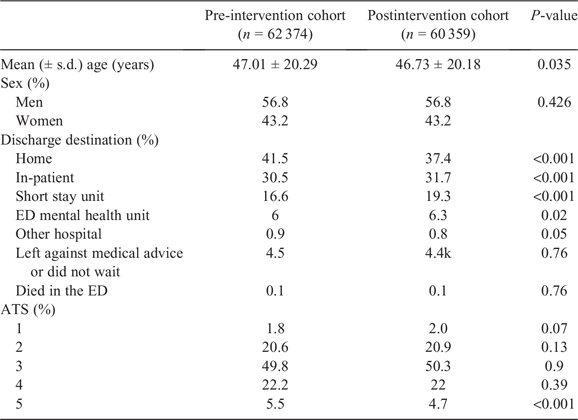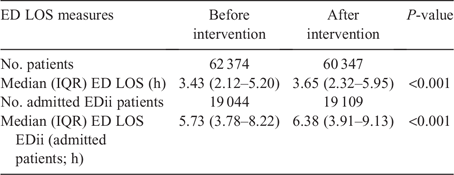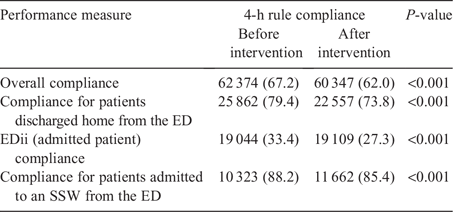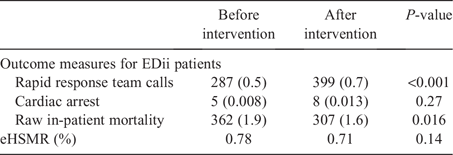Digital transformation of the emergency department-inpatient interface (EDii): integration for future innovation
Andrew Staib A , Clair Sullivan B F , Cara Joyce Cabilan C , Rohan Cattell D and Rob Eley EA Princess Alexandra Hospital, Ipswich Road, Woolloongabba, Brisbane, Qld 4102, Australia. Email: andrew.staib@health.qld.gov.au
B Metro North Hospital and Health Service, Herston Road, Herston, Brisbane, Qld 4029, Australia.
C Emergency Department Princess Alexandra Hospital, 199 Ipswich Road, Woolloongabba, Qld 4102, Australia. Email: carajoyce.cabilan@health.qld.gov.au
D Sydney, NSW 2000, Australia. Email: rohancattell@healthroundtable.org
E Princess Alexandra Hospital, UQ-School of Medicine, 199 Ipswich Road, Woolloongabba, Qld 4102, Australia. Email: r.eley@uq.edu.au
F Corresponding author. Email: clair.sullivan@health.qld.gov.au
Australian Health Review 44(5) 666-671 https://doi.org/10.1071/AH18176
Submitted: 2 September 2018 Accepted: 3 April 2019 Published: 23 October 2019
Journal Compilation © AHHA 2020 Open Access CC BY-NC-ND
Abstract
As the focus of clinicians and government shifts from speciality-based care to system-based key performance indicators such as the National Emergency Access Target (NEAT) or the 4-h rule, integration between emergency department (ED) and inpatient clinical workflows and information systems is becoming increasingly necessary. Such system measures drive the implementation of integrated electronic medical records (ieMR) to digitally integrate these workflows. The objective of this case study was to describe the impact of digital transformation of the ED–in-patient interface (EDii) of a large tertiary hospital on process measures and clinical outcomes for patients requiring emergency admission to hospital. Data were collected from routine clinical and administrative information systems to measure process and clinical outcome measures, including ED length of stay, compliance with the 4-h rule and in-patient mortality between 28 November 2014 and 28 February 2017. The 4-h rule compliance for all patients, as well as for the EDii group (admitted to hospital excluding short stay ward), declined after digitisation. There were 55 fewer deaths in the postintervention group (15% relative reduction; P = 0.02) and a 10% relative reduction in adjusted mortality as measured by the Hospital Standardised Mortality Ratio for emergency patients (eHSMR), which did not reach statistical significance. Digital deceleration in ED performance did occur with an ieMR rollout, but worsening of key patient outcomes was not observed.
What is known about this topic? Much has been written about the introduction of electronic medical records (EMRs) in emergency departments. This work sits alongside a substantial body of evidence outlining the relationship between process measures of ED performance and important patient outcomes. However, much less is known about the impact of digital transformation on the complex adaptive system that is the EDii and the impact of digitisation on the vulnerable group of patients who require emergency admission to hospital.
What does this paper add? The objective of this case study was to describe the effect of a rapid rollout of an integrated EMR. This EMR simultaneously transformed care delivery both in the ED and the inpatient space and impacted on the politically and clinically sensitive performance and outcome measures of the EDii in a large tertiary hospital. The present study is the first that specifically examined the effect of digitisation at the EDii.
What are the implications for practitioners? The understanding that digital deceleration will occur, but that with good patient outcome monitoring worsening of key patient outcomes is not likely to occur, now holds a key place in digital transformation planning. The measures of the EDii examined in this case study provide a foundation for this montoring.
Introduction
As the focus of clinicians and government shifts from speciality-based care to system-based key performance indicators such as the National Emergency Access Target (NEAT) or the 4-h rule, integration between emergency department (ED) and in-patient clinical workflows and information systems is becoming increasingly necessary.1 Such system measures are focused on the patient journey throughout the hospital rather than on the performance of individual departments in isolation.
Traditional information systems such as paper charts and digital systems confined to a single speciality area are unable to provide the real-time, linked, clinically relevant patient data across the system, which is increasingly required to drive for improvement.2,3
A system-wide integrated electronic medical record (ieMR) was introduced at the study hospital in November 2015. There was significant political and clinical interest in the effect of the rapid rollout of this ieMR on the ED and its interface with the in-patient areas (the ED–in-patient interface (EDii)).4 That interest was driven, in part, by the vulnerability of this patient group to system-related factors and anecdotal reports that ED length of stay (LOS) may increase, and that patient outcomes could worsen.5–7
The objective of this case study was to describe the effect of a rapid rollout of an ieMR on the politically and clinically sensitive performance and outcome measures of the EDii in a large tertiary hospital.
Methods
Setting and participants
The Princess Alexandra Hospital is an adult tertiary academic centre seeing over 60 000 emergency presentations per year. The ED previously operated with an isolated digital system for patient tracking and medical documentation (EDIS; Computer Sciences Corporation, Los Angeles, CA, USA). ED nursing documentation was undertaken on paper, as was all in-patient hospital documentation. After digitisation, the entire hospital apart from the intensive care unit and anaesthesia used the integrated Cerner Millennium (Cerner, Kansas City, MO, USA) software. Medication prescription remained on paper for the duration of the study. Anaesthesia remained on a legacy system for the duration of the study.
Methodology
This case study describes the effect of the rollout of an ieMR providing integrated digital clinical information across the EDii for the first time. Data were collected between 28 November 2014 and 28 February 2017 from routine clinical and administrative information systems to measure process and clinical outcome measures, including ED LOS, compliance with the 4-h rule and in-patient mortality. For the purposes of comparative analysis and to minimise seasonal effects, two 12-month periods were compared. The 12-month period immediately before digital implementation (28 November 2014–27 November 2015) was chosen as the pre-intervention group, and the 12-month period from 1 March 2016 to 28 February 2017 was chosen as the postintervention group. The digital go-live period began on 28 November 2015 with the ED, and the remainder of the hospital went live over the following 3-week period. To minimise the effects of temporary factors, the period 28 November 2015–29 February 2016 was considered a transition period, and data for this period were not analysed. In addition, longitudinal monthly data for ED 4-h rule compliance was obtained over the study period.
Data collection
Data were collected from routine clinical and administrative information systems as detailed in Table 1. Patients subject to the EDii were defined as patients who presented and were managed in the ED and were subsequently admitted to a true in-patient ward.
Study outcome measures
These established and routinely monitored measures were defined and collected as described in Table 1.
Statistical analysis
Results were collated and checked using Microsoft Excel (Microsoft, North Ryde, NSW, Australia). Data were analysed using SPSS Version 24.0 (IBM SPSS Statistics for Windows, Armonk, NY, USA) using t-tests for parametric continuous variables, Chi-squared tests for categorical variables and the Mann–Whitney U-test for non-parametric continuous variables. Statistical significance was defined as two-tailed P < 0.05. The Hospital Standardised Mortality Ratio for emergency patients (eHSMR) was calculated de novo using the currently applied Health Roundtable version of previously described methodology6,8,9 for patients admitted into hospital via the ED, and P-values were calculated by comparing the log of standardised mortality ratios (SMR) ratios to a normal distribution.10
Ethics approval
This project was considered exempt from formal ethics review by the Metro South Human Research Ethics Committee (HREC/17/QPAH/107).
Results
Characteristics of the pre- and postintervention groups are given in Table 2. There was a non-significant reduction in overall ED attendances in the post-digital period. There was a non-significant change in patient acuity as measured by the Australasian Triage Scale, except for a small reduction in non-acute (Category 5) presentations.

|
There was a small but significant increase in the proportion of patients admitted in the postintervention group (30.5% vs 31.7% in the pre- and postintervention groups respectively; P < 0.001). Most additional admissions were to the ED short stay unit, and not subject to the EDii.
Hospital process measures for the EDii
Tables 3 and 4 demonstrate the changes in process metrics associated with the digitisation of the EDii. The median LOS increased by 13 min for all patients, and by 39 min for patients negotiating the EDii for in-patient admission.

|

|
Patient outcomes measures for the EDii
There were 55 fewer deaths in the postintervention group (15% relative reduction; P = 0.02). There was a 10% relative reduction in adjusted mortality as measured by eHSMR, which did not reach statistical significance (Table 5).

|
Discussion
The EDii is a critical operating system for all acute hospitals and the performance of the EDii is a subject of considerable interest for politicians, hospital executives and the general public.4 Digital transformation of a hospital is a disruptive event, and digitising the EDii is especially challenging given that time performance is subject to such close scrutiny.11
Process metrics
The results of this study demonstrate an initial increase in ED LOS and a decrease in 4-h rule compliance. This reduction in performance against process metrics occurred across all patient streams in the ED, but was particularly noticeable in the patients subject to the EDii. This again highlights the susceptibility of this patient group to changes in such a complex adaptive system. Such a decrement in time efficiency is described in the literature as ‘digital deceleration’.11 This deceleration has been previously observed during the implementation of isolated ED electronic medical records.12 The deceleration was observed to improve at the index site after the study period. This was observed using routine operational reporting and is shown in Fig. 1.

|
There are many factors that can contribute to digital deceleration. The introduction of any new system requires a period of learning and adjustment that affects the duration and complexity of many tasks in the patient journey. This transformation required many iterations of technical and workflow modifications and the process is still undergoing fine-tuning and optimisation. Ongoing fine-tuning was particularly true in this study, because the study site was the pioneer site for the state of Queensland. Full digitisation of the EDii is complex and had not been previously undertaken in an Australian setting.
Patient outcomes
There was an increase in rapid response team calls to patients admitted via the ED within 24 h. The digital transformation of the hospital included the introduction of a digital deteriorating patient system and linked with an existing body of work encouraging early notification of deteriorating patients. Increased detection of deteriorating patients is associated with a reduction in mortality, and this is likely to be one of many factors contributing to the outcome of our study.13 No significant difference in in-patient cardiac arrest rates was detected before or after digitisation of the EDii.
Digitisation of the EDii was associated with a significant reduction in raw in-hospital mortality for patients admitted via the ED despite a longer ED LOS. We also recorded a 10% relative reduction in risk-adjusted in-hospital mortality for emergency admissions that did not reach statistical significance. There was no evidence of increased harm or worsening of patient mortality outcomes, which was a significant clinical concern before digital transformation.
The previous literature has demonstrated an inverse association between 4-h rule compliance and in-hospital mortality both nationally and at the index site.5,6 The reduction in raw mortality across the digitised EDii in this time period of study may be unrelated to ED LOS and may reflect new methods of care provision with increased availability of clinical information provided by an integrated digital platform mitigating the usual adverse clinical impact of a delayed EDii transit for patients. Further longitudinal characterisation of the relationship between ED LOS and in-patient mortality in a mature digital integrated hospital is required.
Constraints
The relationships demonstrated by such an observational study of a short time period are associations and do not prove causation. They are subject to confounding by other changes that affect such a complex adaptive system. Although the study periods were chosen for their absence of any other major clinical redesign interventions, changes in clinical care delivery and capacity may have affected the study outcome measures. For example, changes in rapid response team activation and awareness may have been a causative factor in reduced mortality.
The use of raw mortality as an outcome measure can be criticised because patient complexity and acuity are not accounted for in this metric. This is a valid limitation and provides only part of an answer to a complex question. Risk-adjusted mortality is a more widely accepted measure and did suggest a reduction that did not reach statistical significance. To achieve a statistically significant result in this metric, a sample size of approximately double that available in the present study would be required. This was not possible in the present observational study due to external factors.
The strength of an observational study is that it reflects real-world practice where digital transformation is always part of a multifaceted transformation in the delivery of patient care. The aim of the present study was not to document the benefit of implementation of an ieMR or attribute causation to the technology itself; rather, the aim was to assess the effect of the transformation of care based on transition to a digital platform at the EDii. The changes in clinical care during the study period were all informed by, or contributed to, digital transformation of patient care in the hospital.
Conclusion
The EDii is a critical operating system in all acute hospitals. Digital transformation of hospitals is complex and affects patient care. The present study is the first that specifically examined the effect of digitisation at the EDii. Despite some slowing of process measures of EDii performance, the transformation appeared safe, with a reduction in raw mortality and no statistically significant difference in risk-adjusted mortality. The safe introduction of an integrated digital platform provides potential for integrated, improved care of the individual patient, a more reliable system and transformation of patient care at the EDii.
The understanding that digital deceleration will occur, but that with good patient outcome monitoring worsening of key patient outcomes is not likely to occur, now holds a key place in digital transformation planning.
Competing interests
None declared.
Acknowledgements
The authors acknowledge those who contributed input and feedback that has been invaluable to the development of this work: Michael Zanco and Clinical Excellence Division, E Health Queensland, Metro South Hospital and Health Service Executive and Clinicians and Metro South Clinical Informatics Team.
References
[1] Staib A, Sullivan C, Griffin B, Bell A, Scott I. Report on the 4-h rule and National Emergency Access Target (NEAT) in Australia: time to review. Aust Health Rev 2016; 40 319–23.| Report on the 4-h rule and National Emergency Access Target (NEAT) in Australia: time to review.Crossref | GoogleScholarGoogle Scholar | 26433943PubMed |
[2] Queensland Health. Digital health strategic vision for Queensland 2016. 2017. Available at: https://www.health.qld.gov.au/__data/assets/pdf_file/0016/645010/digital-health-strat-vision.pdf [verified 4 July 2017].
[3] NSW Health. eHealth Strategy for NSW Health 2016–2026. 2016. Available at: http://www.health.nsw.gov.au/eHealth/Documents/eHealth-Strategy-for-NSW-Health-2016-2026.pdf [verified 4 July 2017].
[4] Staib A, Sullivan C, Prins JB, Burton-Jones A, Fitzgerald G, Scott I. Uniting emergency and inpatient clinicians across the ED–inpatient interface: the last frontier? Emerg Med Australas 2017; 29 740–5.
| Uniting emergency and inpatient clinicians across the ED–inpatient interface: the last frontier?Crossref | GoogleScholarGoogle Scholar | 29090515PubMed |
[5] Sullivan CM, Staib A, Flores J, Aggarwal L, Scanlon A, Martin JH, Scott IA. Aiming to be NEAT: safely improving and sustaining access to emergency care in a tertiary referral hospital. Aust Health Rev 2014; 38 564–74.
| Aiming to be NEAT: safely improving and sustaining access to emergency care in a tertiary referral hospital.Crossref | GoogleScholarGoogle Scholar | 25297518PubMed |
[6] Sullivan C, Staib A, Khanna S, Good NM, Boyle J, Cattell R, Heiniger L, Griffin BR, Bell A, Lind J, Scott IA. The National Emergency Access Target (NEAT) and the 4-hour rule: time to review the target. Med J Aust 2016; 204 354
| The National Emergency Access Target (NEAT) and the 4-hour rule: time to review the target.Crossref | GoogleScholarGoogle Scholar | 27169971PubMed |
[7] Sullivan C, Staib A, Ayre S, Daly M, Collins R, Draheim M, Ashby R. Pioneering digital disruption: Australia’s first integrated digital tertiary hospital. Med J Aust 2016; 205 386–9.
| Pioneering digital disruption: Australia’s first integrated digital tertiary hospital.Crossref | GoogleScholarGoogle Scholar | 27809727PubMed |
[8] Ben-Tovim DI, Woodman RJ, Hakendorf P, Harrison J. Standardised mortality ratios. Neither constant nor a fallacy. BMJ 2009; 338 b1748
| Standardised mortality ratios. Neither constant nor a fallacy.Crossref | GoogleScholarGoogle Scholar | 19403573PubMed |
[9] Australian Institute of Health and Welfare. Australian hospital statistics 2013–14: emergency department care. Health Services Series no. 58. Catalogue no. HSE 153. 2014. Available at: http://www.aihw.gov.au/publication-detail/?id=60129549039 [verified June 2016].
[10] Spiegelhalter DJ. Funnel plots for comparing institutional performance. Stat Med 2005; 24 1185–202.
| Funnel plots for comparing institutional performance.Crossref | GoogleScholarGoogle Scholar | 15568194PubMed |
[11] Sullivan C, Staib A. Digital disruption syndromes in a hospital: important considerations for the quality and safety ofpatient care during rapid digital transformation. Aust Health Rev 2017; 42 294–98.
[12] Deloitte. NSW Health independent review of Cerner FirstNet. 2011. Available at: http://www.ecinsw.com.au/sites/default/files/Deloitte%20Report%20FirstNet.pdf [verified 16 March 2016].
[13] White K, Scott IA, Vaux A, Sullivan CM. Rapid response teams in adult hospitals: time for another look? Intern Med J 2015; 45 1211–20.
| Rapid response teams in adult hospitals: time for another look?Crossref | GoogleScholarGoogle Scholar | 26122775PubMed |



